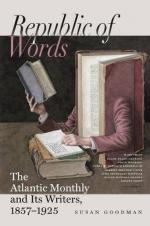It is hardly too much to say, that those whom we love no longer leave us in dying, as they did of old. They remain with us just as they appeared in life; they look down upon us from our walls; they lie upon our tables; they rest upon our bosoms; nay, if we will, we may wear their portraits, like signet-rings, upon our fingers. Our own eyes lose the images pictured on them. Parents sometimes forget the faces of their own children in a separation of a year or two. But the unfading artificial retina which has looked upon them retains their impress, and a fresh sunbeam lays this on the living nerve as if it were radiated from the breathing shape. How these shadows last, and how their originals fade away!
What is true of the faces of our friends is still more true of the places we have seen and loved. No picture produces an impression on the imagination to compare with a photographic transcript of the home of our childhood, or any scene with which we have been long familiar. The very point which the artist omits, in his effort to produce general effect, may be exactly the one that individualizes the place most strongly to our memory. There, for instance, is a photographic view of our own birthplace, and with it of a part of our good old neighbor’s dwelling. An artist would hardly have noticed a slender, dry, leafless stalk which traces a faint line, as you may see, along the front of our neighbor’s house next the corner. That would be nothing to him,—but to us it marks the stem of the honeysuckle-vine, which we remember, with its pink and white heavy-scented blossoms, as long as we remember the stars in heaven.
To this charm of fidelity in the minutest details the stereoscope adds its astonishing illusion of solidity, and thus completes the effect which so entrances the imagination. Perhaps there is also some half-magnetic effect in the fixing of the eyes on the twin pictures,—something like Mr. Braid’s hypnotism, of which many of our readers have doubtless heard. At least the shutting out of surrounding objects, and the concentration of the whole attention, which is a consequence of this, produce a dream-like exaltation of the faculties, a kind of clairvoyance, in which we seem to leave the body behind us and sail away into one strange scene after another, like disembodied spirits.
“Ah, yes,” some unimaginative reader may say; “but there is no color and no motion in these pictures you think so life-like; and at best they are but petty miniatures of the objects we see in Nature.”
But color is, after all, a very secondary quality as compared with form. We like a good crayon portrait better for the most part in black and white than in tints of pink and blue and brown. Mr. Gibson has never succeeded in making the world like his flesh-colored statues. The color of a landscape varies perpetually, with the season, with the hour of the day, with the weather, and as seen by sunlight or moonlight; yet our home stirs us with its old associations, seen in any and every light.




